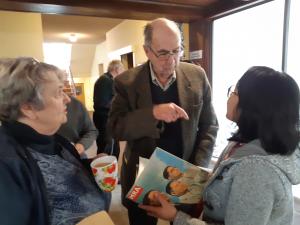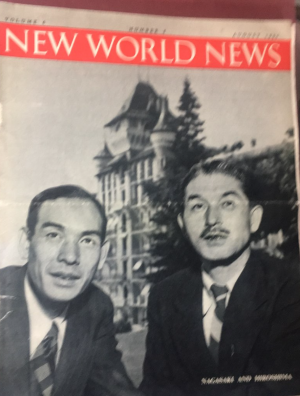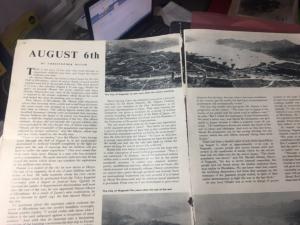World War II ended on 15 August 1945, with Japan’s surrender after the US atomic bombing of the cities of Hiroshima and Nagasaki. Five years later, two men of courage—Shinzo Hamai and Hiroshi Ohashi, mayors of the two cities—visited Moral Re-Armament (the old name for Initiatives of Change) in Caux, Switzerland. Australian journalist Chris Mayor accompanied the men during their time at Caux, and was one of the first in the Western world to interview the pair.
This week, for the 75th anniversary of the end of WWII, ABC News spoke with Chris Mayor about his encounter with the Japanese mayors.
 Now aged 92 and living in Bendigo in regional Victoria, Chris recalls the courage of the men in leaving Japan to face an international community that may have criticised them for Japan’s actions during the war. Yet, he affirms, they came with a message of peace. ‘
Now aged 92 and living in Bendigo in regional Victoria, Chris recalls the courage of the men in leaving Japan to face an international community that may have criticised them for Japan’s actions during the war. Yet, he affirms, they came with a message of peace. ‘
‘It was 5 years after the end of the war, after the bomb, and now, as we look back, we don’t realise how sore the wounds in the world were,’ Chris told ABC News. ‘Thousands killed in an instant. It wasn’t like the Blitz which went on week after week and people being killed, it was 30 seconds. It’s hard to believe how so many people can be eliminated in a flash. It really was a flash…
‘Japan was defeated, humiliated. They were quite courageous coming out of Japan, and meeting the world again. I think it took courage, because they would have expected, I would think, that they were going to be criticised and attacked. They weren’t…These two mayors dedicated themselves to make Hiroshima and Nagasaki centres of peace for the future. They were absolutely determined that the reputation of those two cities would be changed in that way.’
You can watch the three-minute interview with ABC News here:
The two mayors, Hamai and Ohashi, had come as part of a Japanese delegation to an international conference at Caux with other government officials, trade union leaders and business representatives. Chris’ conversation with them took place on a boat on Lake Geneva which was, then as now, ‘a glorious spot.’ Chris recalls that, ‘I thought, rather than just sitting on a couple of benches, why don’t we take them out on a boat, relax, and be away from the hurly-burly of the conference.
'One can build anew with people who are humble,' he added. 'I feel quite touched that they trusted me. It was a gift to have the opportunity of talking with these two men.’
His interview with them ran across two pages of New World News in 1950, an MRA publication. In Chris’ story, the two Japanese mayors expressed their deep commitment to making Hiroshima and Nagasaki centres for peace, and their conviction that the moral  standards of honesty, purity, unselfishness and love would ultimately triumph in the war of ideas.
standards of honesty, purity, unselfishness and love would ultimately triumph in the war of ideas.
In 1950, the United Nations was just five years old, and the war in the Korean Peninsula was just beginning. Chris’ interview highlights the particularities of the atomic blast, the impacts of which were still fresh in the scars of survivors, and the hopes for the future that the Caux conferences helped to build. Hamai, he wrote, lost seven relatives and many friends in the space of just seconds. Ninety-five per cent of his employees were killed or injured in the atomic explosion. Here are excerpts from his piece.
…The official figures stated that some hundred thousand citizens were incinerated that morning, Hamai believes the figure to be nearer two hundred thousand, or half the original population of the city. The official estimate, he says, did not include the 130,000 soldiers who were stationed in the city, 80 per cent of whom were killed. ‘Nearly all the remainder of the population was injured or affected by atomic radiation,’ says the Mayor [Hamai], whose legs still bear scars caused by the deadly rays.
‘There is not one person,’ says the Mayor, ‘who, having lived through the hell of August 6, is not passionately determined to dedicate himself completely to the fight for peace and the task of ensuring that his children will not have to suffer the same experience.…
To questions about the explosion which rocketed the name of Hiroshima into the world’s headlines overnight, Hamai quietly replies, 'I would rather talk about what I believe is the only safeguard against the recurrence of atom warfare….At Caux we find how to accept responsibility for the horrors we have let loose on the world and find also the only sure basis on which the peace we long for can be practically achieved.'
Hamai tells how before coming to Caux his last hope was in some conception of world federal government. ‘Now I am convinced,’ he declares, ‘that if the individual nations within such a world government do not live by the moral standards necessary to outlaw war—absolute honesty, purity, unselfishness and love, which we find at Caux—the whole structure will eventually collapse…From now on I am determined to give everything for this ideology, because when it becomes established in my country and the world, the best form of international government will automatically evolve.'
There had been a deathly quiet of only three days following August 6, when at approximately 11 am in Nagasaki, 130,000 people and 20,000 houses were pulverised in the mushroom of smoke which for the second time rose ten miles into the sky above Japan. ‘The whole population was dazed,’ says Mr Hiroshi Ohashi, Mayor of Nagasaki, ‘for due to severe internal censorship, the people had not heard about the similar explosion three days earlier in Hiroshima. No one knew what had caused the terrifying destruction; but from that moment on, the resistance of the Japanese people ended, in spite of their earlier determination to fight the war to the last ditch.’
At zero hour, Ohashi was at work in charge of 40,000 workers at the large Mitsubishi shipbuilding yards where he had been employed for thirty years. Practically everyone working outside was injured by the blast and radiation though an intervening island saved the docks from severe damage. To this day Ohashi, who was working indoors, believes it was a miracle that he was spared. Like the Mayor of Hiroshima, the Mayor of Nagasaki feels he was saved for a special purpose and that he has a destiny to fulfil for his people. These men came to Caux and together found what they believe to be the common destiny for both...
In August 1949 the Japanese Diet passed two Bills declaring Nagasaki and Hiroshima to be officially-constituted centres for culture and world peace. Says Ohashi, ‘We want to establish in Nagasaki a centre which can contribute to the permanent culture and peace of the world. But I realised that was not enough, so I came to Caux to find the spirit which alone could make practical our effort to outlaw war and ensure peace.
‘Through our bitter experience of the atom bomb we are determined to fight to see that such weapons and the hydrogen bomb are never used.’ Whether there is a war of arms or not, Mr Ohashi is sure that the war of ideologies will grow more intense, and it will be continuous. But he concludes confidently, ‘In the long run, Moral Re-Armament will prove to be the superior ideology of all, because Moral Re-Armament is the decisive force in that war of ideas that the atom bomb proved to be in that war of arms.’
- Chris Mayor, New World News

